

![]()
Book Reviews
|
Features
|
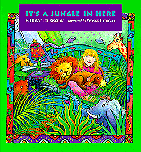
|
It's a Jungle in Here.
Deanne Lee Bingham. Illustrated by Yvonne Cathcart.
Toronto: Second Story Press, 1995. 24pp.
Preschool - Grade 1 / Ages 3 - 6.
**1/2 /4
|
excerpt:
I love to swim.
I am a great swimmer.I jump into the water
and stay under for a long, long time,
just like a fish.
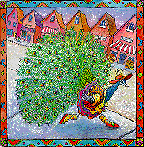 VIBRANT AND INVENTIVE ILLUSTRATIONS will make the simple story of It's a Jungle in Here attractive to young readers. Allison is a girl who likes to see her life in terms of wild animals and their adventures -- a fish when she swims, a bear when she's brave, a lion when she's angry.
VIBRANT AND INVENTIVE ILLUSTRATIONS will make the simple story of It's a Jungle in Here attractive to young readers. Allison is a girl who likes to see her life in terms of wild animals and their adventures -- a fish when she swims, a bear when she's brave, a lion when she's angry.
Each short section of text has a facing full-page illustration of what Allison imagines, and a smaller picture beneath the words showing what's really going on. For example, when Allison says "I can run really fast. Faster than a flash of lightning. As fast as a cheetah," the illustration below the text has her dog pulling her along behind its leash (a good image for a young child of when you have to run fast).
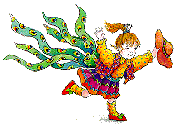
But the facing page shows how Allison imagines the situation. She reverses the situation, becoming a racing cheetah (you can tell it's still Allison because the cheetah is wearing the same clothes), while her dog is happily pulled along, clinging to the cheetah's neck. Appropriately, the facing-page fantasy illustrations are set off in bright frames, while the real-life illustrations are just dropped onto the text pages.
The text is very simple, perhaps befitting the early-reader target audience; it seems to function as the plainest possible recounting of the story told by the illustrations. And the story has the sort of grounded fantasy and wish-fulfilment that appeals to young children.
But in a book with hardly three hundred words, it's distressing that neither writer nor editors caught one glaring, if common, grammatical error, confusion of lay and lie:
Sometimes my sister looks too comfortable.Lay/lie is easy enough for kids to get wrong as it is; they don't need help like this!
So, I lay low in the grass and quietly
slither over to surprise her,
just like a snake.
My other hesitation regards the title (which is repeated as dialogue in the last line of the book). As a play on the expression "it's a jungle out there," it's cute, but both the expression and the joke will need explaining to most four- or five-year-olds. Of course, it also has a more literal meaning that is clear enough: the illustration on the last page reveals that Allison's fantasies are based on the real, stuffed, and toy animals that live in the bedroom she shares with her sister.
An appealing premise, and clever and attractive illustrations, but there are some problems with the simple text.
Recommended with reservations.
Diane Fitzgerald is an elementary-school teacher in Saskatoon.
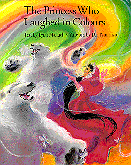
|
The Princess Who Laughed in Colours.
Lynn Manuel. Illustrated by J.O. Pennanen.
Grades 2 - 5 / Ages 6 - 10.
***/4
|
excerpt:
When the princess gazed out upon the silent emptiness, the steep cliffs on one side, the icy sea on the other, she wondered if she was doomed to dwell forever apart from her family and friends. Shivering in her thin dress, she wandered the land day after day in search of colours. And the warm breath of her sighs became white puffs in the cold wind.
THE PRINCESS WHO LAUGHED IN COLOURS is an admirable Canadian fairy tale. Princess Winona is admired everywhere not merely for her beauty and kindness, but for her laughter, which "was as golden and violet as the crown upon her head, as mellow green as an overgrown garden, as crimson and amber as a sunset, as royal blue as the sea."
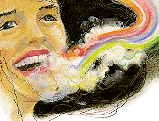
A jealous queen in a neighbouring kingdom, worried about how undesirable (and unmarriageable) her daughters seem by comparison, places a curse on Winona, who awakes "in a barren northland where the sun gave no warmth."
Winona is trapped for some time in the North, at first frightened by its odd, colourless, dancing creatures (whales, polar bears, frost flies). Gradually she learns to appreciate them, and joins in their dance. And her resulting happy laughter brings spring to the northland, "as golden and violet as the crown upon her head, as mellow green as an overgrown garden, as crimson and amber as a sunset, as royal blue as the sea."
The spell broken, Princess Winona returns home, and every year thereafter her friends from the North come to visit, bringing the cold with them, a time that comes to be called "Winter."
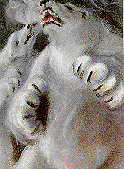
J.O. Pennanen's excellent pastel illustrations work well -- the pictures of the eerie dances of the pale northern creatures, and the enveloping colours of Princess Winona's laughter are excellent. And Lynn Manuel's text does some real myth-making appropriate to this northern country: unexpectedly you find this conventional fairy tale has aspects of a creation story, explaining both spring in the arctic and winter in the rest of the world.
Perhaps the story relies too heavily on the concept of the Princess "who laughed in colours." The fairy-tale frame is a little too conventional at first (we probably don't need more stories about jealous curses that keep beautiful Princesses from finding appropriate princes); later it seems forgotten as the story ends in a rush -- Winona laughs, the spell is broken, and she (somehow) returns home.
Lynn Manuel's text uses repetition and repeated patterns well, but at times it seems stilted (and, for my taste, overuses exclamation marks). And -- though this is a very small point -- "Winona" is such a trendy name that it lacks a mythic feel.
But The Princess Who Laughed in Colours is a fine piece of Canadian myth-making. And whatever reservations I have about stories of princesses' marriage troubles, young girls seem to like them as much as ever. The attractive illustrations and central theme should make this a popular book.
Recommended.
Diane Fitzgerald is an elementary-school teacher in Saskatoon.
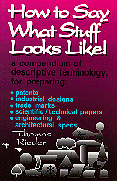
|
How to Say What Stuff Looks Like!
Thomas Rieder.
Grades 10 and Up / Ages 14 to Adult.
*** /4
|
excerpt:
. . . Here is some trivia that might come in handy one day, for example when at a cocktail party you are desperately seeking some clever conversational gambit to intrigue and entertain the Potential Significant Other (PSO) who has been smiling at you all evening: all positive numbers can be divided into three kinds: Abundant Numbers, Deficient Numbers and Perfect Numbers. . . .
 THEN AGAIN, it may never come in handy. But that captures the tone of this light-hearted, almost eccentric reference work on descriptive terminology. Author Thomas Rieder, a long-time patent agent, spent many years collecting accurate definitions of shapes that he regularly encountered (and had to describe). After he realized people other than patent agents might find his work useful, that list became the origin of How to Say What Stuff Looks Like!
THEN AGAIN, it may never come in handy. But that captures the tone of this light-hearted, almost eccentric reference work on descriptive terminology. Author Thomas Rieder, a long-time patent agent, spent many years collecting accurate definitions of shapes that he regularly encountered (and had to describe). After he realized people other than patent agents might find his work useful, that list became the origin of How to Say What Stuff Looks Like!
Roget's Thesaurus and other reference works had similar humble beginnings. In recent years, visual dictionaries have been appearing of greater and lesser usefulness -- the dry Canadian Stoddart Visual Dictionary (1986), for example, or the more useful and colloquial What's What (Random House, 1981). Neither of those books has Rieder's concentration on geometrical description, however -- in fact, they hardly cover geometrical forms at all.
Geometry is the core of technical description, however, and Rieder's book provides not only page after page of simple but clear illustrations, enabling you to flip through the appropriate section to find out that a square with a smaller square taken out of one corner is properly called a gnomon; use the index to find a picture of a term whose precise definition you can't remember; or just be enlightened by his sections of general explanation. For example:
What may not be generally known is that many of the "uniform" shapes to be dealt with in this chapter ["Two-dimensional Curvilinear Figures"] are what we call conic sections, meaning that they have shapes that can be produced by cutting a standard cone along certain planes. The drawing at the top of page 22 shows how the circle, the ellipse, the parabola and the hyperbola can be generated by passing a flat plane through a circular cone at various angles. . . .

Surprisingly clear and succinct. And throughout Rieder provides touches of wit in both the definitions and the drawings (for example, in the illustration defining crater-like, a small stick-figure flees in terror from what appears to be a volcano -- certainly a crater-like shape).
The audience for the book is probably narrower than the casual title would suggest, however. Most of the text is limited to defining geometric terms (loxodrome, for example) that will only rarely be of use to a non-specialist, particularly of student age. On the other hand, senior science and geometry students will find themselves at a loss for ways to describe shapes from time to time, and the definitions and illustrations here will help them quickly.
Rieder's book is as friendly and accessible as the subject allows, and it has been bound to lie flat without breaking the spine. There are a few annoyances, however -- for instance, the text uses typewriter-style quotation marks, rather than typographical ones. The medium in which CM is published has the same limitation, but in physically printed work it's the first sign of lazy (or amateur) design.
And since many of the definitions are unavoidably cross-referential, it's frustrating that all defined terms aren't marked off by boldface when they appear, and made easier to find. For example, the definition of a triangle uses the term vertex, but if you don't know the word, you must read the next page before finding that Rieder defines it for you. Similarly with parralelogram, the definition of which appears after Rieder begins using it to define other four-sided shapes. More work needs to go into the next edition.
In all, a slim and entertaining work on a subject of limited usefulness.
Recommended with reservations.
T.S. Causabon is a freelance writer in Winnipeg formerly unaware of the difference between a spiral and a helix.
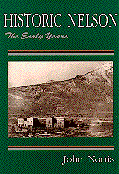
|
Historic Nelson:
John Norris.
Lantzville, BC: Oolican books, 1995. 319pp, paper, $21.95.
Grade 11 and Up / Ages 16 - Adult.
****/4
|
THIS IS NOT A NORMAL HISTORY. Historic Nelson invites us to witness the story as if we are an audience watching actors perform on the stage, knowing more than they do, but not knowing the outcome. This relationship between the reader and the history creates a feeling of mystery and expectation. John Norris produces the drama of Historic Nelson on vast stage, vividly describing the geography of the West Kootenay and the colourful characters who have parts in the play.
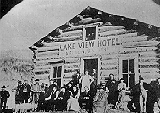
Norris brings the story to life with rich prose that elevates Historic Nelson to a work of literature. For example, he writes that in the spring of 1882, the landscape of the West Kootenay area, "lay voluptuously responsive to the triumphant sunshine." Norris's powers of description are so vivid that we feel we too are paddling canoes with the early settlers and their Indian guides.
Similarly, the characters in Historic Nelson are real people with real feelings and emotions. Photographs of many of the protagonists, and the author's recreation of their personalities, and even conversations, bring them to life.
Writing Historic Nelson required a great deal of digging through both primary and secondary historical sources, something the author seems to have enjoyed a great deal. Where there are gaps in the story, Norris fills them in by offering several possibilities and then making what seems to be the most logical choice. Readers can enjoy participating in piecing together this historical jigsaw puzzle, becoming historians themselves.
The most exciting parts of the book deal with the chance discovery of minerals and the staking out of claims. Here the unfolding drama fulfils the author's claim that the early pioneers of the West Kootenay "were going to enact a tale of money-lust, betrayal, revenge, flight, pursuit, capture and punishment worthy of an opera." There is all of that and more, including a murder and the execution of a man who was likely innocent. Readers have plenty ahead of them as they watch Nelson develop out of nothing into a thriving, bustling city.
Numerous maps add to the value of Historic Nelson, although a distance scale would have made them more useful -- anyone not familiar with the West Kootenay region will refer to them frequently.
Highly recommended for anyone living in B.C., and anyone interested in history and the pioneer spirit.
Thomas F. Chambers is a professor at the Canadore College of Applied Arts in North Bay, Ontario.
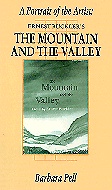
|
A Portrait of the Artist:
Barbara Pell.
Professional (senior Language Arts).
***/4.
|
excerpt:
. . . Sociological or historical importance is not enough in itself to warrant reading and studying The Mountain and the Valley as a literary classic. But in its evocation of geography and history, it touches on themes of universal importance. . . . The philosophical concerns that [Buckler] articulates are the twentieth-century themes of alienation, loss, and death; he explores them within the framework of the modernist psychological novel of artistic maturation and isolation.
THE MOUNTAIN AND THE VALLEY (1952) is an early Canadian example of the literary genre a friend once called "Portrait of the Artist as a Tiresome, Self-Absorbed Young Git." (He added that The Mountain and the Valley was somewhat redeemed by killing off its protagonist at the end.) This is probably overly harsh.
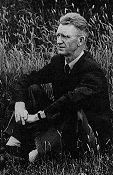
But like many mid-century Canadian novels, The Mountain and the Valley does suffer from self-consciousness about writing a Canadian novel, and in this case a Canadian novel about a writer (a more successful, also highly self-conscious example from this period is Hugh MacLennan's Two Solitudes). Buckler, MacLennan, and other mid-century writers paved the way for writers of what we could call Canada's mature period, beginning perhaps with Margaret Laurence, writers comparatively free of the anxiety of being literary pioneers.
Barbara Pell's examination of Buckler's only well known work is part of ECW Press's "Canadian Fiction Studies" series. Pell provides not only reasons why the book still repays attention, but a balanced and comprehensive introduction that will give Language Arts instructors a good entrance to teaching The Mountain and the Valley. Pell, a professor of English at Trinity Western University, considers the various swings of critical opinion and academic thought about Buckler's book, and its central character, with only occasional (and probably unavoidable) lapses into crit-speak, but the bulk of the book is her own analysis, one which is well considered, free of jargon, and essentially correct.
In this "portrait" David Canaan, the failed writer who is the book's protagonist, is tiresome because he is supposed to be. His flaws, his selfishness, his inability to act decisively -- or to realize that even inaction has irreversible consequences -- bring him to his pathetic end. He dies still dreaming (only dreaming) of becoming a great writer who will give voice to the rural Nova Scotia life he can neither escape nor embrace. Meanwhile, his grandmother, practising her rug-making, goes about actually making art from the lives around her with no self-consciousness at all.
Buckler's writing was dense, allusive, and almost as self-conscious as David himself. Pell points out its flaws and virtues, illuminates its structure, and glosses its references.
I remain unconvinced that The Mountain and the Valley belongs on the high-school curriculum, but I wish I'd had Pell for a professor when I was in grad school. For those who are teaching the novel, Pell's book is probably essential; it may even be a useful resource for advanced students, especially if they're armed with a copy of A Glossary of Literary Terms.
Recommended.
T.S. Causabon is a Winnipeg-based writer.

Man seeks order and pattern in all things
Be ready to change your paradigm.
Archives of past puzzles and winners lists are available at:
http://www.odyssee.net/~academy/mathpuzzle/mathpuzzlecontest.html
The Little Math Puzzle is on summer holiday, but there are still a few answers that haven't been posted.
Question #34 asked:What is the next number following this pattern?
235, 2225, 255, 2235, 257, 22225, ________The answer is 2335.
Each number is made up of the prime factors of the numbers 30, 40, 50, 60, 70, 80, so the next number is 90 (2x3x3x5)
 Winners -- Solvers of Puzzle #35
Winners -- Solvers of Puzzle #35The solution 259 (2x5x9 = 90) was found by:
Andrea Pollock and Alex Nazarov
math_puzzle@rwa.psbgm.qc.ca
Royal West Academy, Montreal West, Quebec.

a) independently
b) as a team or group
c) as a team or group representing a class or school
Many historians claim that the Cold War became public in Ottawa, in 1946, with the defection of a Soviet cipher clerk, who revealed the presence of Soviet spy rings in North America.Name this Soviet cipher clerk.
DUE DATE FOR THIS ANSWER: 8 June, 1996
Steve_Caldwell@colby.on.infoshare.ca or stepcald@enoreo.on.ca
The first commercial oil well in North America was located in Canada.Name the location of this well.
 Winners
Winners
![]()
|
Executive Assistant Peter Tittenberger  e-mail: cm@umanitoba.ca
e-mail: cm@umanitoba.ca
|
 majordomo@mbnet.mb.ca
majordomo@mbnet.mb.ca
Postal address:
CM
100 Arthur Street, Suite 208
Winnipeg, MB R3B 1H3
![]()
Copyright © 1996 the Manitoba Library Association.
Reproduction for personal use is permitted only if this copyright notice
is maintained. Any other reproduction is prohibited without
permission.
Published by
The Manitoba Library Association
ISSN 1201-9364
![]()
WELCOME | BOOK REVIEWS BY AUTHOR | BOOK REVIEWS BY TITLE
AUDIO/VIDEO/CD-ROM REVIEWS | VOLUME II INDEX | SEARCH